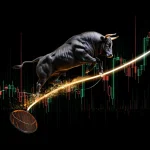
How to read stochastic oscillator?
Feb 18, 2025
Have you ever wondered if the secret to untangling market chaos lies not in blind faith but in the art of deciphering numerical rhythmic pulses? The stochastic oscillator stands as a beacon of insight amidst the tumult of fluctuating prices, offering the discerning trader a window into the subconscious impulses that drive markets. In an era where every tick of the index seems to echo the herd’s irrational impulses, the call to truly understand this technical indicator is both a challenge and an invitation. How does one transform raw, seemingly opaque data into a coherent narrative of market momentum? The answer lies in examining the oscillator’s dual nature: a tool born of rigorous quantitative analysis yet deeply entwined with the timeless principles of human behaviour. This dynamic interplay demands not only an analytical mind but also a spirit willing to question conventional wisdom. Reading the stochastic oscillator, therefore, is not merely about capturing numerical signals; it is about engaging with the very pulse of the market, recognising when exuberance morphs into mania and when despair births opportunity. As we journey through this essay, we shall blend ancient philosophical wisdom with cutting-edge investing insights, challenging you to see beyond the surface of overbought and oversold signals and to embrace a more nuanced, contrarian perspective that transforms market uncertainty into a strategic advantage.
Understanding the Stochastic Oscillator: Its Essence and Utility
At its core, the stochastic oscillator is a momentum indicator developed in the late 1950s, designed to compare a security’s closing price to its price range over a specified time period. The fundamental principle is delightfully simple: prices tend to close near the extremes of their recent range when a new trend is emerging. In practical terms, the oscillator comprises two lines – %K, which is the fast-moving indicator, and %D, a slower, smoothed version that provides signal confirmations. Traders utilise these lines to identify conditions of overbought and oversold markets. When the %K line moves above %D in the lower region (often below 20), it typically signals that the market is oversold and, conversely, an overbought condition when the %K line falls below %D in the upper region (often above 80). Such thresholds are not arbitrary but are steeped in the idea that extremes in market sentiment often precipitate reversals. This elegant synthesis of mathematics and market psychology is where timeless wisdom meets modern technical analysis.
To the uninitiated, the stochastic oscillator may appear as merely an arcane collection of percentages and thresholds. Yet, a deeper understanding reveals it as a mirror of collective behaviour – a subtle reflection of the cognitive biases and emotional swings that dictate market movements. Recognising that human beings tend to overreact to news and events, the oscillator quantifies these reactions into actionable intelligence. By focusing on where the closing price positions itself within its recent high-low range, the oscillator transforms the chaotic ebb and flow of market price action into a refined metric capable of guiding both novice and seasoned traders alike. Thus, learning how to read the stochastic oscillator necessitates an intellectual journey that traverses both the realms of theory and practical application.
The Intersection of Mass Psychology and Technical Analysis
Markets, for all their algorithmic precision, are ultimately driven by human emotion. Fear, greed, euphoria, and despair are not mere side effects of trading but the very lifeblood of market dynamics. The stochastic oscillator, in this regard, encapsulates a form of mass psychology – translating the collective mood of traders into quantifiable data. When the oscillator indicates that a market is overbought, it is often because a surge of collective optimism has inflated prices beyond their intrinsic value. Conversely, an oversold signal usually reflects a state of panic, where the fear of loss has driven prices to a nadir. Understanding these signals through the lens of behavioural finance is akin to reading the unspoken language of the market’s emotional landscape.
Historical market crashes and bubbles offer vivid illustrations of this phenomenon. The dot-com bubble, for instance, was characterised by an overabundance of bullish sentiment; prices soared as investors, gripped by the bandwagon effect, ignored fundamental valuations. The stochastic oscillator, had it been widely utilised, would have warned of overbought conditions, highlighting the imminent risk of a dramatic correction. Similarly, during periods of market panic, such as the global financial crisis of 2008, the oscillator can alert the astute trader to oversold conditions, paving the way for contrarian buying. Thus, mastering the stochastic oscillator is not merely a technical endeavour but also an exercise in decoding the psychological contagion that often turns disparate market events into explosive trends.
Timeless Wisdom and Modern Investing: A Fusion of Insight
Throughout the annals of history, great thinkers have emphasised the importance of self-awareness and proactive reflection in decision-making. The ancient maxim “know thyself” resonates profoundly when we consider the practice of metacognition in trading. In essence, reading the stochastic oscillator is as much about understanding the trader’s own internal biases as it is about analysing external data. When one recognises that overconfidence and herd mentality frequently lead to market extremes, the oscillator emerges not simply as a predictor of price movement but as a tool for introspective clarity. This fusion of timeless wisdom with modern analytical techniques empowers you to adopt a more objective stance, moving beyond impulsive reactions to embrace a disciplined, reflective approach.
Imagine a trader who, instead of succumbing to the panic of an oversold market, uses the oscillator to verify that a temporary dip is likely to reverse. Or consider the contrarian investor who, alerted by an overbought signal, chooses to question the prevailing sentiment and prepare for a strategic exit. Such examples illustrate how a profound understanding of both human nature and technical indicators can create a robust framework for decision-making. The integration of philosophical introspection and practical market analysis paves the way for a more balanced, effective investing strategy. It is this synthesis of old-world sagacity and contemporary data-driven insights that sets the stage for truly transformative trading practices.
Contrarian Tactics: Advanced Strategies to Harness Oscillator Signals
In the realm of high-stakes trading, contrarian tactics have often been the province of those brave enough to defy the conventional wisdom of the herd. The stochastic oscillator, when read correctly, becomes a compass pointing towards opportunities where the market’s irrational exuberance or despair has created temporary inefficiencies. Advanced traders harness these moments by adopting strategies that are both bold and methodically calculated. For instance, when the oscillator dips below a critical threshold, signalling an oversold condition, contrarian investors might purchase shares, confident that the market will soon correct itself. Conversely, when the indicator touches the upper extreme, a well-timed exit or even a short sale might be in order.
Yet, such strategies require more than mere audacity; they demand a solid grounding in risk management and an unflinching capacity for self-reflection. One advanced manoeuvre involves coupling oscillator signals with other indicators such as the Relative Strength Index (RSI) or Moving Average Convergence Divergence (MACD) divergences. When these technical signals converge, the probability of a significant market turnaround increases, providing a reliable cue for action. Moreover, some traders even venture into options strategies—selling put options during heightened volatility to capture inflated premiums, then reinvesting those gains into long-term call positions once the market stabilises. These sophisticated techniques exemplify how, by meticulously reading the stochastic oscillator within a broader analytical framework, traders can transform perceived market chaos into a calculated advantage.
In these moments of strategic defiance against conventional sentiment, modern investing achieves its highest form of expression. The oscillator not only charts the numerical fluctuations of price but also the underlying currents of fear and optimism that sway market decisions. By integrating contrarian tactics with rigorous risk management and a deep awareness of market psychology, you position yourself to reap the rewards where others see only uncertainty. This is the essence of mastery in technical investing—a relentless pursuit of clarity amid the unpredictable, where every signal is both a challenge to be met and an opportunity to be seized.
Risk Management and Disciplined Trading: The Backbone of Strategy
The allure of technical indicators and contrarian strategies can be intoxicating, but without a disciplined approach to risk management, even the most insightful trader is doomed to falter. When you choose to read and act on the signals provided by the stochastic oscillator, you are engaging in a battle against both market volatility and your own cognitive biases. The very traits that can make contrarian tactics profitable—timeliness, decisiveness, and high conviction—must be tempered by a commitment to preserving capital and managing risk. This is where a disciplined trading strategy becomes indispensable.
Effective risk management involves setting clear, predetermined parameters: stop-loss orders to limit downside, stringent position sizing to avoid over-leveraging, and a diversified portfolio to mitigate exposure to any single asset class. These tactical precautions serve as the safety nets that protect you from the inherent uncertainties of the market. It is a practice that echoes the ancient wisdom of measured restraint, reminding us that the path to lasting success is paved with cautious optimism rather than reckless audacity. In this framework, reading the stochastic oscillator is seen as an art of timing the market and a critical component of a broader system of checks and balances.
Moreover, disciplined trading is about more than just financial preservation—it is a mindset. A trader who consistently questions their assumptions rigorously evaluates their strategies and adapts to the evolving landscape of market data automatically build resilience against the pitfalls of emotional decision-making. In an environment rife with cognitive biases—from loss aversion to the bandwagon effect—a disciplined approach grounded in technical analysis is the antidote to the chaos of impulsive, uninformed decisions. When you integrate the insights gained from the stochastic oscillator into a comprehensive risk management strategy, you are not merely reacting to market conditions; you are actively sculpting your financial destiny with precision and foresight.
Conclusion: Empower Your Trading Journey with Clarity and Confidence
In the intricate dance of market movements and investor sentiment, the stochastic oscillator emerges as an invaluable tool—a guide that transforms raw numerical data into a narrative of potential opportunities and calculated risks. To truly master the art of reading the stochastic oscillator is to embrace a philosophy that marries the timeless wisdom of introspection with modern, data-driven precision. As you navigate the turbulent waters of market volatility, let this indicator be your compass, illuminating the subtle shifts in momentum and sentiment that dictate market trends.
Remember, the true power of the stochastic oscillator lies not merely in its ability to signal overbought or oversold conditions, but in its capacity to reveal the rhythm of collective human behaviour. It is a mirror reflecting not only price fluctuations but also the undercurrents of optimism, fear, and contrarian defiance that shape our financial world. By cultivating the discipline to interpret these signals amidst the noise, you empower yourself to make bold, informed decisions that go beyond the superficial allure of market trends.
As you embark on this journey of technical mastery, challenge yourself to think critically and act decisively. Integrate the oscillator’s signals with a well-reasoned trading plan, embrace advanced contrarian strategies when the moment is ripe, and never lose sight of the importance of risk management in guarding against the volatility of human emotion. Your success in the markets will be measured not just by the fortunes you accumulate but by the clarity with which you understand and control your own cognitive processes.
Let this be your call to action: empower your trading journey by delving deep into the mechanics of the stochastic oscillator, and let its patterns guide you through the perplexities of modern investing. By fusing timeless intellectual insights with cutting-edge technical analysis, you can turn market chaos into a calculated, strategic advantage—one that enables you to navigate volatility with unwavering confidence and a clear vision for the future.












